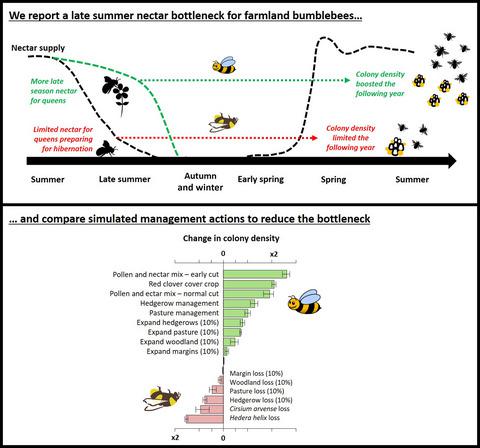当前位置:
X-MOL 学术
›
J. Appl. Ecol.
›
论文详情
Our official English website, www.x-mol.net, welcomes your
feedback! (Note: you will need to create a separate account there.)
Bumblebee colony density on farmland is influenced by late‐summer nectar supply and garden cover
Journal of Applied Ecology ( IF 5.0 ) Pub Date : 2020-12-24 , DOI: 10.1111/1365-2664.13826 Thomas P. Timberlake 1, 2 , Ian P. Vaughan 3 , Mathilde Baude 4 , Jane Memmott 1
中文翻译:

农田中大黄蜂的菌落密度受夏末花蜜供应和花园覆盖的影响
更新日期:2020-12-24
Journal of Applied Ecology ( IF 5.0 ) Pub Date : 2020-12-24 , DOI: 10.1111/1365-2664.13826 Thomas P. Timberlake 1, 2 , Ian P. Vaughan 3 , Mathilde Baude 4 , Jane Memmott 1
Affiliation

|
- Floral resources are important in limiting pollinator populations, but they are often highly variable across time and space and the effect of this variation on pollinator population dynamics is not well understood. The phenology (timing) of floral resources is thought to be important in structuring pollinator populations, but few studies have directly investigated this.
- Our study quantifies the landscape composition, seasonal nectar and pollen supply and Bombus terrestris colony density of 12 farms in southwest UK to investigate how landscape composition influences the phenology of floral resources and how both these factors affect colony density. We use this information in a spatially explicit predictive model to estimate the effect of different farmland management scenarios on seasonal resource supplies and colony density.
- We find that farmland nectar supply during September is a strong predictor of B. terrestris colony density in the following year, explaining over half of all the variation in colony density; no other period of resource availability showed a significant association. Semi‐natural habitat cover was not a good proxy for nectar or pollen supply and showed no significant association with colony density. However, the proportional cover of gardens in the landscape was significantly associated with colony density.
- The predictive model results suggest that increasing the area of semi‐natural flowering habitat has limited effect on bumblebee populations. However, improving the quality of these habitats through Environmental Stewardship and other management options is predicted to reduce the late‐summer resource bottleneck and increase colony density.
- Synthesis and Applications. Our study demonstrates the importance of considering the phenology of resources, rather than just total resource availability, when designing measures to support pollinators. Late summer appears to be a resource bottleneck for bumblebees in UK farmland, and consequently management strategies which increase late‐summer nectar availability may be the most effective. These include mowing regimes to delay flowering of field margins until September, planting late‐flowering cover crops such as red clover and supporting late‐flowering wild plant species such as Hedera helix. Our results also suggest that rural gardens may play an important role in supporting farmland bumblebee populations.
中文翻译:

农田中大黄蜂的菌落密度受夏末花蜜供应和花园覆盖的影响
- 花卉资源在限制传粉媒介种群方面很重要,但是它们在时间和空间上经常变化很大,而且这种变化对传粉媒介种群动态的影响尚不十分清楚。人们认为花卉资源的物候(时序)在构造授粉媒介种群时很重要,但很少有研究对此进行过直接调查。
- 我们的研究量化了英国西南部12个农场的景观组成,季节性花蜜和花粉供应以及Bombus terrestris菌落密度,以调查景观组成如何影响花卉资源的物候学以及这两个因素如何影响菌落密度。我们在空间明确的预测模型中使用此信息,以估计不同农田管理方案对季节性资源供应和殖民地密度的影响。
- 我们发现9月份的农田花蜜供应量是次年B. terrestris菌落密度的有力预测指标,解释了全部菌落密度变化的一半以上。没有其他时期的资源可用性显示出显着的关联。半自然生境覆盖物不能很好地替代花蜜或花粉的供应,并且与菌落密度没有显着相关性。但是,景观中花园的比例覆盖与菌落密度显着相关。
- 预测模型结果表明,增加半自然开花栖息地的面积对大黄蜂种群的影响有限。但是,通过环境管理和其他管理措施改善这些栖息地的质量预计将减少夏末资源瓶颈并增加菌落密度。
- 综合与应用。我们的研究表明,在设计支持传粉媒介的措施时,考虑资源物候的重要性,而不仅仅是总资源的可用性。夏末似乎是英国农田中大黄蜂的资源瓶颈,因此增加夏末花蜜可用性的管理策略可能是最有效的。这些措施包括割草制度,以将田间边缘的花期推迟到9月,种植晚花的有盖作物,例如红三叶草,并支持晚花的野生植物品种,例如常春藤。我们的结果还表明,乡村花园可能在支持农田大黄蜂种群方面发挥重要作用。











































 京公网安备 11010802027423号
京公网安备 11010802027423号